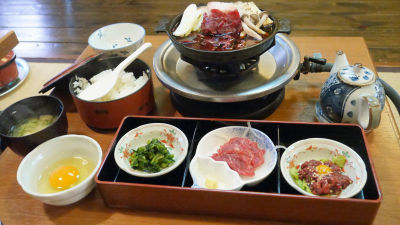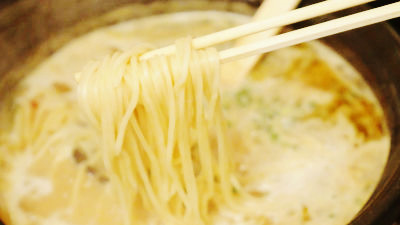I went to Taiyoshi Hyakuban, a restaurant that was once a red-light district where courtesans lived and is now a registered tangible cultural property.Report

The address of Taiyoshi Hyakuban is 3-5 Sanno, Nishinari Ward, Osaka City, Osaka Prefecture. It is about a 10-minute walk from Tennoji Station, Abeno Station, and Dobutsuen-mae Station.
So, I took a long walk from Tennoji Station and arrived at Taiyoshi Hyakuban. If a woman walks around Taiyoshi Hyakuban at night, the taxi driver will warn her, ``You shouldn't stay in a place like this, go home early.'' If you're worried, you might want to take a taxi from the station. It is best to go from Tennoji Station through a residential area and take the stairs in front of Osaka Municipal Kanazuka Elementary School.
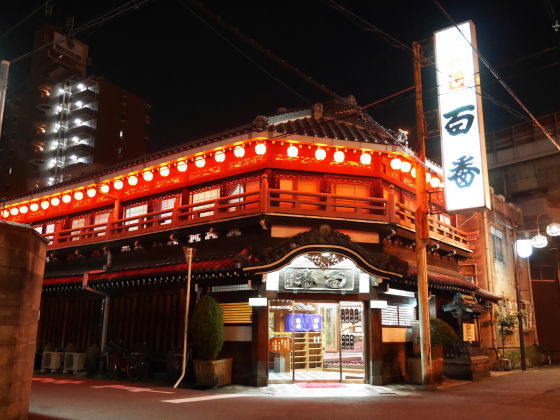
When I entered the store, there was a

So, when I changed into slippers and went inside...
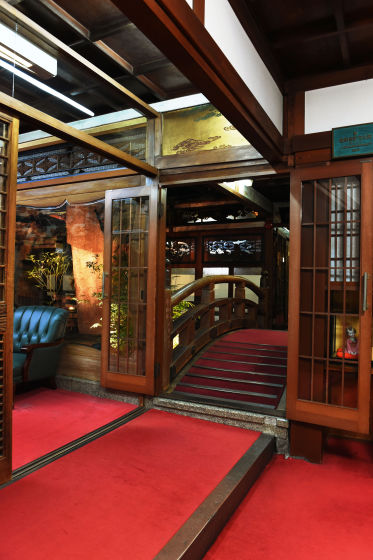
There was a lobby and a reception room.
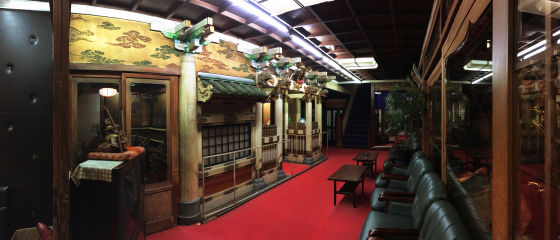
This is the entrance to the drawing room. When you pass through the entrance modeled after the Yomeimon gate of Nikko Toshogu Shrine ...


Inside is like this.

By clicking on the image below, you can scroll through the image and see the room in 360 degrees.

When you look back at the entrance from inside the room, you will see

There are decorations all over the walls, and the space is filled with patterns, patterns, patterns that can only add up.

A dragon on the ceiling.

I am overwhelmed by the gorgeousness of the lions and chrysanthemums.

There are pictures of flowers on the golden folding screen. The slightly faded color reminds us of the vibrancy and splendor of the time.

Gold carvings at the feet.

When the entrance door was closed, it looked like this, with a gold phoenix drawn in black letters.

There is a sleeping cat on the door.

The structure of Taiyoshi Hyakuban is like this, with a Japanese garden in the middle, in the shape of a circle.

There is a bridge over the doorway next to the lobby, and you can see the courtyard from the bridge.

I was overwhelmed by the majesty and otherworldliness, but I was getting hungry, so I had to eat first. There are tatami rooms on both the 1st and 2nd floors, but this time I was guided to the 2nd floor. So when I go up the stairs...

The floor on the second floor was purple.

Even though it's inside a building, the hallway has a roof and has long chairs, giving it the feel of a downtown area at the time.

There are plants on the walls and a moon on the ceiling, making it clear that they are aware of the outside world.

The room I was shown to was the 'Suzunoma' room. Compared to the reception room, which is full of glittering gold decorations, it gives a very clean impression.

The desk looks like this.

Taiyoshi Hyakuban's menu includes kaiseki meals that cost around 4,500 yen (including tax), as well as dishes such as yose-nabe, chanko-nabe, live sea bream chiri, and crab chili that are reasonably priced at around 3,000 yen per person. This time, I chose yose-nabe because it is popular in winter.

Otoshi is made with salmon roe, chirimenjako, and wakame marinated in vinegar.

The ingredients in the pot look like this.

Starting with beef and chicken...

Seafood such as clams, sea bream, and shrimp are also available.

There were also plenty of vegetables.

In addition to Chinese cabbage, mitsuba leaves, green onions, tofu, etc., we also have yuba (yuba) and mochi (rice cakes).

You can also order a la carte dishes such as edamame and shrimp tempura.

The drink menu looks like this:

The shop staff will use a chukkaman to light the stove, so wait until it simmers.

Put the ingredients...

Once the fire passes, it's done. The pleasant scent of dashi fills the room and whets the appetite.

So, I will put it on a plate and eat it.

Big clams...

chicken meat.

Serve with hot meat and vegetables.

Seafood...

Conger eel

shrimp

Yuba etc.

In addition, you can order udon for 210 yen including tax, and udon for 420 yen including tax.

The slightly thin udon noodles go down smoothly and go down smoothly. The deep-flavored special soup stock made it possible to enjoy every bite until the end, and the amount was so large that it would be difficult for two women to finish it, so it seems to be a good value for money despite being a Japanese restaurant.

The room I was taken through was relatively clean, but I heard that each room had a variety of designs, so I decided to explore the inside of the building. First of all, there is ``Kitahachi no Ma'', which has a magnificent gate even though it is inside a building.

There are pictures of houses and waterfalls on the walls, and trees are sticking out.

In front of the entrance, it says ``Tokaido 53 Stations Shimada Inn'' and it seems that even the detailed settings have been made.

I asked a customer who was eating inside to show me the interior. Kitahachi no Ma has a raised space inside the room that resembles a houseboat.

On the ceiling is a carving of the Oigawa River.

The door is painted with a picture of a waterfront that must have once been brightly colored, showing that a thorough effort was made to create the atmosphere.


Go to yet another room. Next time I push the heavy wooden door...

It was ``Murasaki Shikibu's Room'' with a ceiling that looked like the bottom of a ship.

The slightly unusually shaped windows are decorated with beautiful decorations.

The window that connects to the hallway is a unique accordion style.

``Chiyo no Ma'' has a refreshing atmosphere similar to the room where we ate.

Also, the largest hall on the second floor looks like this. The fusuma is golden.

The unique feature of this room is that it has a stage. At that time, courtesans may have stood here and performed their tricks.

There was a folding screen in the back of the room that was clearly modern, so I looked behind it and saw a door...

It led to a small room further back.

There was a small room, apparently used as a dressing room.

In addition, the ceiling of the ``Yura no Ma'' was beautifully decorated, with countless flowers painted on it.


In addition, some rooms have windows overlooking the elegant courtyard.

After enjoying the second floor, I will go down to the first floor. There are decorations everywhere, including the stairs and bright paintings on the walls.

You can check the 360 degree image of the hallway by clicking on the image below.

I didn't notice it when I entered the store, but there was a place called 'Face Show Room' on the left immediately after entering the entrance...

It looked like a stage. At that time, the courtesans might have sat here and showed their faces.

The sliding door depicts a pine tree and a white hawk.

Proceed through the narrow hallway ......

The most glamorous building on the first floor is Momoyama-dono, which has a Momoyama-style design so gorgeous that the shop's description even describes it as ``infinitely vulgar.'' Three spaces are connected by a cutout, and in the past, it was used as a castle for courtesans, and was used for entertainment as well as for living.

You can also see the inside from the celestial sphere photo by clicking on the image below.

Clicking on the image below also shows a celestial sphere image from a different position.

Momoyama-den consists of three rooms: ``Peony,'' ``Phoenix,'' and ``Shien-den,'' and each room has a carving named after it on the door.


An elaborate transom surrounds the room, and the ceiling is painted in more chic colors than the Yura-no-ma room on the second floor.

A wooden sliding door with a picture of a person on it.

A faded gilded folding screen.

Even the alcove is gorgeous in a way rarely seen in private houses.


After leaving Momoyama-dono, I walked around the narrow passageway...

The place we arrived at was a toilet called ``Seijoden.''

You can check the 360 degree celestial image by clicking below.

Even though it is a toilet, there is a peacock sitting at the entrance and flowers dancing. The toilets are also the same as they were back then, so they are unisex.

The interior was all blue, with bright chrysanthemums blooming on the ceiling.


Related Posts:
in Coverage, , Posted by darkhorse_log



